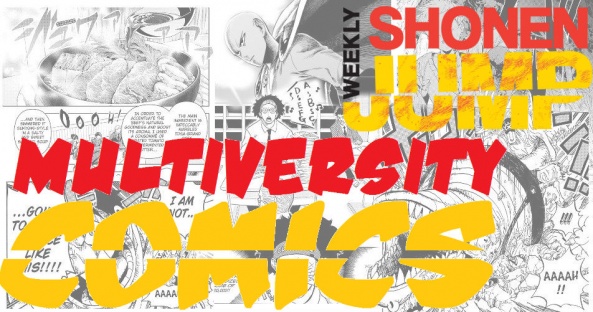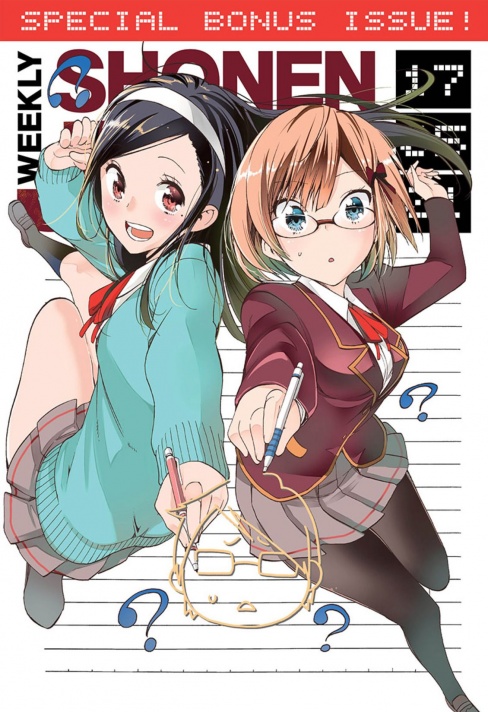
Welcome to This Week in Shonen Jump, in which a rotating duo of Multiversity staffers take a look at two stories contained in each installment of Viz Media’s Weekly Shonen Jump. For the uninitiated, Weekly Shonen Jump is an anthology that delivers more than 200 pages of manga of all varieties. We hope that you’ll join us in exploring the world of Weekly Shonen Jump each week. If you are unfamiliar, you can read sample chapters and subscribe at Viz.com.

This week, Zach and Vince are back – and they’re good again! If you have any thoughts on the two titles discussed this week, or thoughts on “We Never Learn,” let us know in the comments!

Dr. Stone Chapter 8
Written by Riishiro Inagaki
Illustrated by Boichi
Reviewed by Zach Wilkerson
The latest chapter takes a break from the burgeoning conflict with Tsukasa, wherein we get a small science lesson and a bit of character development. Since being revived from stone, Yuzuriha’s presence has been fairly small, with the majority of the plot focusing of the conflict brewing between the other three characters. This chapter does shift the focus to Yuzuriha somewhat, though it’s in the frame of Taiju’s unrequited love for her. The “I almost confessed by love to you but then ‘X’ horrible thing happened so now I must postpone my confession” trope is straight out of a CW drama (here’s looking at you, Arrow). Taiju is both noble and chivalrous, but I fear that such a decision casts Yuzuriha as little more than a prize awaiting the hero at the end of his epic journey.
The other half of this chapter deals with the group crafted gunpowder to use in their fight against Tsukasa. Much like fellow Weekly Shonen Jump book “Food Wars,” “Dr. Stone” spends some time in “Senju’s Kitchen,” explaining the science and process behind the making of gunpowder. The section is very fun, and expresses the information in a way that most can easily pick up on. So much so, in fact, that there’s an included disclaimer for children to not start crafting bombs! Inagaki-san weaves these educational tidbits into the plot seamlessly, so that as you learn that the volcanic rock is ridden with iron pyrite, you pick up on the disastrous consequences of Taiju’s action.
The collaboration between Inagaki and Boichi continues to be the strongest aspect of “Dr. Stone.” Boichi’s style adapts to each type of scene in subtle and satisfying ways. His “base” style, used in more serious scenes, uses thick black lines and great detail to embolden the characters as larger than life archetypes. Conversely, his style takes on a more fun and comedic tone for the chapter’s “educational segments” as well as the book’s gags, which are occasionally pretty funny. Boichi captures a wide range of emotion and melodrama, crafting a story that visually hooks the reader from the start.
“Dr. Stone” is still finding its footing eight chapters in, which is not uncommon for a new manga series. The book is still sorely lacking in substantial character development, with each character representing little more than a recognizable archetype. The book does well by leaning on its high concept to drive the plot, but I hope to eventually come to enjoy the characters more as well. With the first major conflict with the book’s primary antagonist brewing, as well as the hint of a new twist in the proceedings, there’s plenty of reason to check out “Dr. Stone.”
Final Verdict: 7.5 – Beautifully illustrated, fun, and educational. That’s a pretty solid trifecta.

ROBOT x LASERBEAM: Chaper 6
Written and illustrated by Tadatoshi Fujimaki
Review by Vince J Ostrowski
The latest chapter of “ROBOT x LASERBEAM” opens in the middle of a match play golf game between the school’s golfing ace Yozan Niura and our unfazed protagonist Roboto Hatohara. One of the best things the manga does right away is simply and quickly explain how match play works for the uninitiated and demonstrates how someone who’s never actually played golf on a course before could best an opponent who is superior to them. Fiction sometimes has a way of glossing over some of the details with whatever sport they’re depicting and not really being clear about how a character’s skills are helping them succeed, but “ROBOT x LASERBEAM” does a fantastic job of this. The manga also doesn’t feel the need to make the protagonist into an unstoppable golf badass, showing that while he’s a savant who uses his brain like a computer processor to figure out how to hit perfect shots, he’s not infallible and still needs to learn a lot of the nuances of golf. This plays out in a humorous scene where he makes 11 bad swings in a row, taking huge divots out of the turf like Spauling Smails from Caddyshack.
Continued belowIf “ROBOT x LASERBEAM” has any storytelling faults, it’s that the manga is overstuffed with internal monologue from its characters, to the point that it really begins to read like the worst episodes of the dubbed Speed Racer anime where every character is explaining their thoughts and observations very quickly and in excruciating detail. On the one hand, this is definitely helpful to someone who isn’t familiar with golf. Yozan’s observations of Roboto’s game are rife with good explanations for why someone who can technically hit the perfect shot doesn’t yet understand how to take into account things like the thickness of the grass, the wind, and the angle of the lie of the ball. On the other hand, this stuff is also wordy and repetitive to the point where it easily good have been streamlined. This wordy internal dialogue also hampered the issue from a technical standpoint, as more than a handful of the thought bubbles and exclamations actually begin to cover up the art in significant ways. There’s also a panel or two where I flat out couldn’t read the dialogue as typed because they crammed it into the word bubbles in a font that was not only small, but appeared to be stretched vertically to make it fit. I tried reading this on two different devices and the problem remained – the words were simply unreadable. I’d be interested to see the manga in its original Japanese to see if these problems were as bad, or if they simply sprung up in the translation out of necessity.
The art itself is very handsomely done. Fujimaki-san draws appropriately expressive characters and makes the golf action dynamic and exciting (as far as golf goes). He also shows a knack for injecting humor into the golf itself in a very visual fashion. He goes out of his way to draw the course with detail and the individual shot situations with relative accuracy – frankly there’s more detail than is needed, and it’s appreciated. It’s also interesting that Fujimaki uses iconography (including an actual prominent golf brand) and references to real life golf events. It’s further evidence that “ROBOT x LASERBEAM” is making a conscious effort towards accuracy and realism to balance out its humor and pseudo-science. Perhaps most wouldn’t even notice these kinds of things, but Fujimaki efforts to include them when he can and it’s appreciated.
Final Verdict: 5.9 – ROBOT x LASERBEAM is a conventional sports manga that’s just “good enough” on its own, but this installment was especially marred by some very noticeable technical problems.






